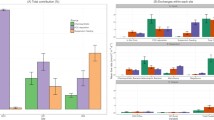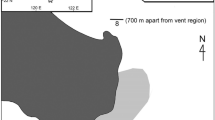Abstract
Cold-seep communities have relatively low diversity, are dominated by one or two taxa present in high density and high biomass in comparison with the surrounding fauna, and are restricted to aphotic habitats. Their associated heterotrophic fauna are usually distinctive from the fauna of their surroundings. In contrast, a more commonplace chemoautotrophically based community occurs in shallow photic habitats. The associated heterotrophic fauna includes many of the species typical of the surrounding communities and typically dominates abundance, whereas the species with chemoautotrophic symbionts dominate biomass. All modern seep assemblages are deeper than 550 m. Many fossil seep assemblages occurred in water as shallow as the mid-shelf (<200 m). In contrast, communities where species with chemoautotrophic symbionts are biomass dominants, but not numerical dominants, are common in shallow waters at present but rarely reported in the geological record. We suggest that the absence of cold-seep communities on the continental shelf presently is due to a combination of predation and competitive exclusion by primary consumers limiting the presence of species dependent on chemoautotrophic symbionts. We suggest that cold-seep assemblages are more common at shelf depths in the fossil record for two reasons: (a) The biases of preservation have accentuated their distribution by transforming communities where species with chemoautotrophic symbionts dominate by biomass, but not numerically, into cold-seep-appearing assemblages. (b) The importance of predation pressure and oligotrophy has varied, with decreased predation pressure accompanying increased oligotrophy favoring cold-seep communities. We suggest that the paucity of shallow-water assemblages with species harboring chemoautotrophic symbionts as biomass dominants in the fossil record is based on the reliance of paleoecological analysis on numerical abundance data when energy flow analyses are required to identify these assemblages. The distinctiveness of the fossil seep assemblage is intensified by taphonomic processes that bias the assemblage against small individuals and epifaunal species, so that diversity declines, the small heterotrophic component of the assemblage is significantly reduced, and the epifaunal component is minimized. The final assemblage is usually dominated by the better-preserved large infaunal clams which perchance are also the species with chemoautotrophic symbionts. In contrast, preservation does not enhance the distinctiveness of these chemoautotroph-harboring species in shallow water.
Similar content being viewed by others
Author information
Authors and Affiliations
Additional information
Received: 16 April 1998 / Accepted: 29 June 1999
Rights and permissions
About this article
Cite this article
Callender, W., Powell, E. Why did ancient chemosynthetic seep and vent assemblages occur in shallower water than they do today?. Int Journ Earth Sciences 88, 377–391 (1999). https://doi.org/10.1007/s005310050273
Issue Date:
DOI: https://doi.org/10.1007/s005310050273




